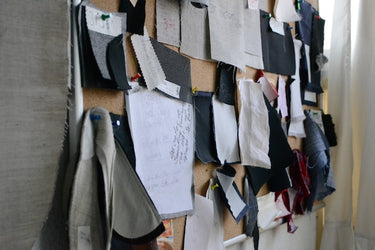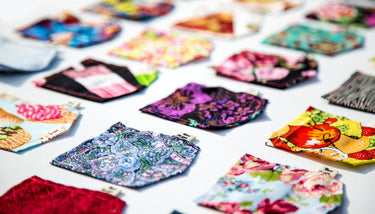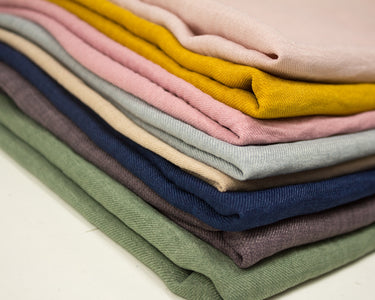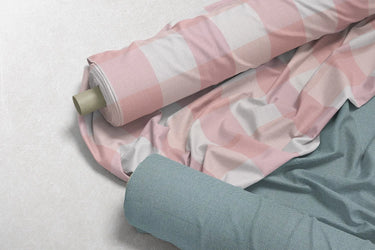

Upholstery webbing is a strong, closely woven fabric used to make items such as straps and belts and support the seats of upholstered chairs.
When first embarking on any upholstery project, it's hard to know which one will be most suitable. But there are four core types of upholstery webbings that you can use. Below we identify the different types of webbing and when to use them for various upholstery projects:
JUTE WEBBING
Features:
- Natural fibre
- Strong but can sag over time
- No elasticity so requires coil springs
- Widely available
Use for:
- Wooden frames
- Vintage/restoration projects
- Natural fibre projects
Jute is a natural fibre spun into extremely strong bands. These bands are then stretched over the back or over seats of furniture frames to sit other upholstery components on, such as springs.
Furniture makers have used jute in upholstery for many years. It was virtually the only material used for upholstery webbing until the 1950's when synthetic materials became a popular replacement. Some beginners may search for cotton upholstery webbing in older projects, but they need much stronger jute.
Jute also requires coil springs for comfort and support, making the upholstery process of jute webbing far more complex than rubber webbing.
RUBBER WEBBING
Features:
- Very strong
- Great elasticity
- It doesn't sag and has good longevity
- It doesn't require springs
Use for:
- Any fixing such as grooves or upholstery tacks
- Simple or streamlined furniture
- Replacing webbing in modern or high-traffic furniture
Rubber webbing is a prevalent resource in upholstery and is considered the most elastic upholstery webbing. Due to its inherent strength and elasticity, you don't need coil springs, lowering the production costs of furniture. Grips usually fix rubber webbing into grooves on furniture. But it can be fixed directly to a wooden rail with upholstery webbing tacks or staple gun if there are no grooves.
Rubber webbing is considered superior to jute webbing by upholsters because it will not sag over time and has far more longevity. It is currently the most popular webbing used in furniture manufacturing, making up 90% of furniture products made in Europe. Parker Knoll chairs nearly always use rubber webbing.
BLACK & WHITE WEBBING
Features:
- Strong and durable
- Less likely to sag than pure Jute webbing
Use for:
- Natural projects
- Vintage projects with double cone springs
- Tacking fixings
Black and white webbing is also known as English webbing and often comes in a herringbone design. It is a robust woven webbing ideal for tacking to furniture as a solid and durable base.
Upholsters use black and white webbing under double cone springs as it is strong enough to manage the pressure from the top and bottom cones.
POLYOLEFIN WEBBING
Features:
- Synthetic webbing
- Resistant to water damage and rot
- Very long-lasting
Use for:
- Outdoor furniture
- Modern furniture
- Spring-free furniture
- Plastic or metal furniture frames
Polyolefin webbing is a woven synthetic product constructed from a petroleum-based production process. It's created in a woven pattern and used similarly to jute webbing but doesn't require springs. It's also slightly more expensive but will not be susceptible to water damage or rotting unlike jute or rubber webbing.
WHEN TO REPLACE UPHOLSTERY WEBBING
Webbing doesn't need replacing as often as the top fabric on your furniture. Often, individuals think it needs replacing if the seat sags from below. But in reality, some sagging is a good sign as it shows the spring pressure is going to the bottom, not the top.
Webbing needs replacing when it begins to break down or becomes overstretched. Only experience will genuinely tell you when it is time to replace webbing. But you can test the webbing by throwing something with some weight into it, like an upholstery tool. If the object you carefully drop on the webbing bounces, it is still working.
HOW TO REPLACE UPHOLSTERY WEBBING
Replacing upholstery webbing depends on the constrictions of the chair and the materials used, such as the presence of springs. But as a general guide, upholstery webbing should be replaced using the following steps:
- Remove all upholstery layers to expose all of the webbing.
- Take note of how stretched or damaged the old webbing has become and see if a different type of webbing may avoid any future problems.
- Take photos and note the current webbing weave, specifically, which pieces are on top and how many there are.
- Cut the webbing in each piece's centre and remove any fixings such as dowels or tacks.
- Next, cut and lay out all of your new webbing strips. Count your vertical and horizontal pieces to ensure there are enough.
- Begin adding all of your new webbing pieces in one direction. Use a lever or second pair of hands to get each piece as tight as possible when pulling the web. Once taught, fix the webbing straps in place with grooves, staples or tacks. Add as many fixings as required as they will be covered up. You won't be able to reinforce them once the fabric cover is back on.
- Once you've completed the webbing in one direction, weave in the webbing in the opposite direction.
- Test your webbing tautness and adjust any looser pieces before completing your project.
Are you looking for webbing for your next projects? Browse upholstery supplies and high-quality webbing on the Millshop Online.












